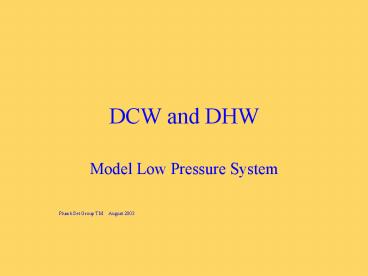DCW and DHW PowerPoint PPT Presentation
1 / 11
Title: DCW and DHW
1
DCW and DHW
- Model Low Pressure System
- Plumb Set Group TM August 2003
2
Domestic Main Cold water feeds
- Main rises through Domestic Stop Cock (1)
- A drain off valve will be installed in line
immediately after the stop cock - Mains water is supplied to the kitchen sink (2)
to provide a potable supply. - Mains water rises to the Domestic Cold Water
(DCW) storage cistern (3) (normally located in
the roof space). - Water level in the DCW cistern (3) is controlled
by a float valve. - As water is drawn from DCW cistern (3) it will be
replenished from the rising main. - There is an externally venting overflow mounted
25mm below the main feed into the tank (green)
3
Domestic Low Pressure Cold Water
- Water contained in the DCW Cistern (3) is fed at
low pressure to various installations such as the
bath (5), sink (6) and toilet cistern (7) - The actual pressure will depend on the static
head. - Pipe work is normally in 22MM copper though it is
likely to rise in 15MM section to the toilet
cistern (7) and possibly to the wash basin (6)
for neatness. - An Isolation valve is installed in line on the
rise to the toilet cistern, to enable ease of
float valve maintenance.
4
Domestic Hot Water feed
- The Domestic Hot Water (DHW) Cylinder (4) is fed
directly from the DCW Cistern (3). A shut off
valve (probably a gate valve - not shown here)
will normally be installed in the area of the DHW
Cylinder. - The Low pressure cold feed to the DHW Cylinder
always enters the cylinder near the bottom
because - Cold water is heavier than hot water and so would
sink anyway and - If cold water is introduced at the top of the
cylinder it will cause a swirling action and mix
with hot water already stored there. Water would
then become tepid.
5
Domestic Hot Water Heating Circuit
- Hot water leaves the boiler (8) via the 22MM
Primary Flow copper pipe which takes it to the
top of the DHW heat exchanger (worm) immersed in
the water held in the DHW Cylinder (4). - As the Primary Flow passes down through the Worm,
it conducts heat through the copper walls of the
Worm, and heats the water contained in the DHW
Cylinder (4). - The water in the Worm never comes into contact
with the water in the DHW Cylinder (unless a
fault has occurred). - Water leaving the Worm (Primary Return) has given
off much of its heat to the Water in the DHW
Cylinder. It returns to the boiler (8) to be
reheated so that the process can continue.
6
Domestic Hot Water Supply
- Hot water flow depends on the opening of a tap or
valve (such as a hot water valve on a washing
machine). - For a hot water flow to commence, the open tap or
valve must be situated below the top of the water
level in the DCW cistern (3) - Hot water contained in the DHW cylinder (4)
naturally rises to the top of the cylinder and
the hot water exit is therefore at the top.
7
Domestic Hot Water Supply (cont)
- When a tap is opened, the hot water is pushed out
of the DHW cylinder by the cold water from the
DCW Cistern (3) which enters the DHW cylinder (4)
at the base. - Remember - the hot water is pushed out by the
cold water entering the DHW cylinder (4) because
there is a head of cold water. That is to say
that the water level in the DCW cistern (3) is
higher than the water level in the DHW cylinder.
8
Balanced HC Water - safety features
- Boiler high temperature thermostat will limit
temperature in primary flow. - If this fails and the primary flow overheats
water will expand and either cause a pressure
relief valve to open or water will overflow back
to a feed and expansion (FE - not shown here)
tank if fitted. - DHW Cylinder thermostat limits DHW temperature
(set to 65 degree C) - If hot water in the cylinder expands too much it
is vented back into the DCW cistern. If this
results in the cistern becoming overfull the
external overflow from the cistern will operate.
Note the position for the connection of the DHW
supply vent pipe work (into the DHW outlet but at
least 450MM from the DHW cylinder).
9
Balanced DCW DHW Schematic
10
Balanced Domestic HC Water
- Advantages
- Hot and Cold pressure is the same at all
installations except the kitchen sink - A limited cold water supply is maintained if the
main supply is temporarily cut - The call on the the main is reduced at peek times
- Lower specification valves (such as gate valves)
can be deployed on Low Pressure pipe work - Low Pressure supply is quieter in operation.
Small flaws such as loose tap washers and long
unsupported pipe runs are unlikely to pose noise
problems. - Cold water supply to the kitchen sink can be
maintained whilst the Low pressure DCW system is
being serviced.
- Disadvantages
- Low pressure DCW supply may not be potable
- A Low pressure system is more prone to freezing
- Toilet cisterns take longer to fill than those
supplied by the main - Have to locate and close DCW cistern Low Pressure
supply valve, to work on Low Pressure cold water
applications. Where no valve exists, have to
drain DCW cistern
11
DCW and DHW
- Model Low Pressure System
- Plumb Set Group TM JULY 2003

